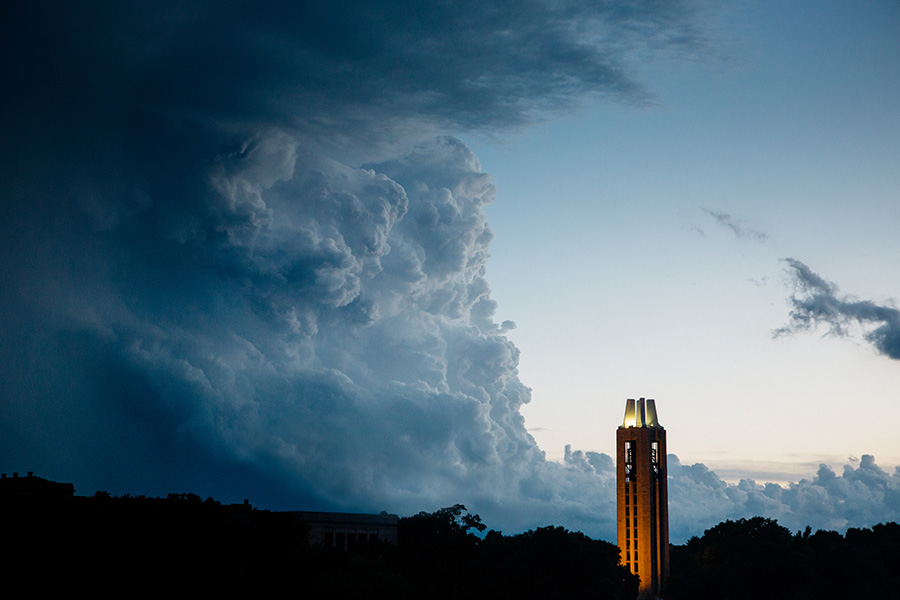Campanile Storm

In 2016 I was a new photographer at KU Marketing Communications. I had been a brand manager at Sunflower Outdoor and Bike Shop and had only been shooting for about three years. I was self-taught, so getting hired at KU was the affirmation I needed— but I wanted to prove myself as soon as I could.
On the July day this photo was taken, my wife and I were chatting with a friend who was visiting from Minnesota. Through the windows in our living room, I noticed something funky happening outside and went out to look. You know how sometimes as a storm approaches the air gets calm and the light turns strange colors and creates an odd mood? I love that light, and the light was doing that thing.
The ephemeral nature of ever-changing cumulonimbus clouds — boiling, rolling turbulent water vapor with a mind of its own — cares not if you got your frame, so you have to move fast. I ran back into the house. I told them, “I’m going to campus to take photos, and we have to go right now.”
Like Cartier-Bresson’s notion of the “decisive moment” in a scene, there are moments of coalescence in the atmosphere that you can’t plan for or imagine — like the intersections of just the right light, just the right loft in the cloud, the perfect hint of drama, and the relationship of sky and land that is just-so. A wall cloud like this transforms completely in seconds. And if you have any hope of shooting that decisive moment, you need have your eyeball in the viewfinder ready to acknowledge it. A moment later, the sky may be beautiful and worth dedicating a few minutes of your life to observe, but it won’t create the powerful photo you imagined. Luckily, on this day, we made it in time.
As we crested Mount Oread and started down Jayhawk Boulevard in my little gray Nissan, I saw exactly where I needed to be. In the Memorial Union parking garage, I set up a tripod and grabbed my camera. I shot 21 frames.
It isn’t often I know I’ve “got it” after a shoot. Usually I am chasing ideas, working the problems, arranging compositions, checking sharpness — and during that process it can be tough to know how good the stuff actually is. My co-photog Meg says that I hate everything I shoot for two weeks. She may be kidding, but she’s pretty much right. For me, it usually takes time and fresh eyes to see and acknowledge the good stuff. But not this time.
I knew I was photographing something special. I was happy I was there. I was invigorated. I was super thankful I have a patient wife! I was so happy to bring that photo back to the office to show my new colleagues. It was encouraging to contribute something great right out of the gate. It was the antidote I needed to fight off the imposter syndrome. For all those reasons, it’s one of my favorite photos I’ve ever shot.
Technically speaking
The lens.
A wide shot of the campus would have been OK, but a wide-angle lens exaggerates the distance between objects. (Ever see a room on a rental or reality site that looks spacious only to find out it’s smaller than your current tiny living room? That’s a wide-angle lens for you.)
I used a long telephoto lens (70-200) because I knew the best way to show this scene was to compress it. Not only do zoom lenses allow you to, well, “zoom,” they compress the distance in the frame. Distance between objects is visually compressed, bringing things from the background and the foreground to a more even plane. The longer the lens in focal length, the more compression you get.
In this photo, that means I visually compressed the distance between the cloud and the campanile to play up their relationship and to simplify the frame by framing out distracting, unimportant elements.
The tripod.
The clouds blocked most of the light from the descending sun in the west. I used a tripod because I wanted to keep the ISO as low as possible, at the expense of hand-holdable shutter speed.
The natural blue ambient light level created a nice color temperature contrast with the warm glow of the campanile display lights.
The second advantage of using a tripod is the intentionality it demands. Another layer of pre-visualizing the final frame is forced into the decision-making process as you mount your camera to a static position. (And what is photography if not a decision-making process?)